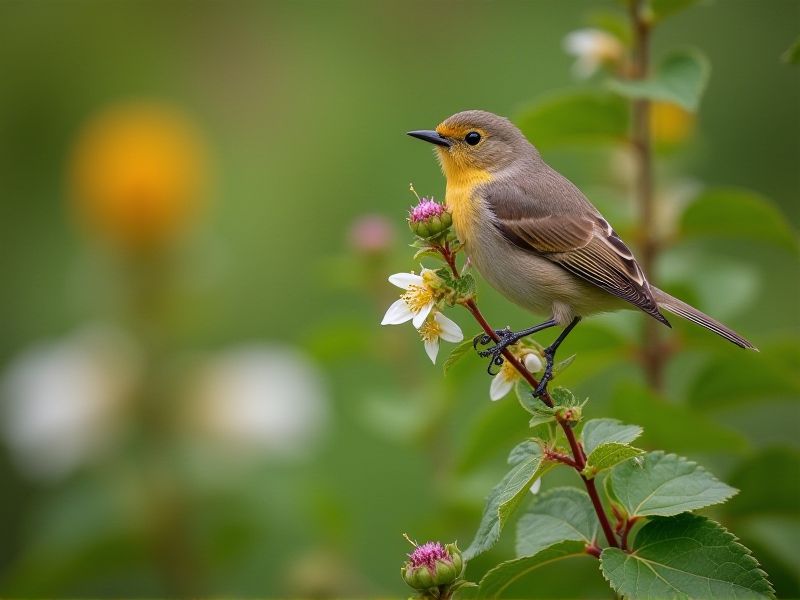
Woodland plants such as serviceberry, dogwood, and viburnum provide essential food sources and shelter for songbirds. Serviceberry, with its nutritious berries, attracts species like thrushes and grosbeaks during the summer months. Dogwood not only produces colorful fruits but also offers dense foliage, creating a safe nesting environment. Viburnum species, known for their abundant berries, serve as a year-round food source for various songbirds, especially in the colder seasons. Incorporating these native plants into your garden can enhance bird biodiversity and create a vibrant ecosystem.
List of some Woodland plants that attract songbirds
- Eastern Red Cedar (Juniperus virginiana)
- Flowering Dogwood (Cornus florida)
- American Holly (Ilex opaca)
- Serviceberry (Amelanchier arborea)
- Black Gum (Nyssa sylvatica)
- Red Mulberry (Morus rubra)
- Highbush Blueberry (Vaccinium corymbosum)
- Spicebush (Lindera benzoin)
- Black Cherry (Prunus serotina)
- Elderberry (Sambucus canadensis)
Important things about Woodland plants that attract songbirds
Native Plant Selection
Woodland plants such as serviceberry, viburnum, and red maple play a crucial role in attracting songbirds to your garden. These native species offer essential food sources, including berries and seeds, while providing natural shelter for nesting and protection from predators. Incorporating a variety of understory plants, like ferns and wildflowers, creates a rich habitat that supports diverse bird populations. By choosing these native woodland plants, you enrich your landscape while fostering a vibrant ecosystem for local songbirds.
Berry-Producing Species
Woody plants such as serviceberry (Amelanchier spp.) and elderberry (Sambucus spp.) are essential for attracting songbirds in woodland areas. These berry-producing species not only provide a vital food source but also offer nesting habitats for various bird species. By incorporating plants like native black chokeberry (Aronia melanocarpa) and blueberries (Vaccinium spp.) into your landscape, you enhance biodiversity and create a thriving ecosystem. Planting these species in clusters fosters foraging behavior, making your woodland more appealing to songbirds year-round.
Dense Foliage For Shelter
Dense foliage in woodland areas provides essential shelter and nesting sites for songbirds. Native shrubs such as serviceberry and elderberry offer both protective cover and a food source, attracting a variety of avian species. Trees like dogwood and hawthorn not only contribute to the structural complexity of the habitat but also produce berries favored by songbirds during the fall and winter months. By incorporating these plants into your landscape, you can create a vibrant ecosystem that supports local bird populations.
Nectar-Rich Flowers
Woodland plants such as the redbud (*Cercis canadensis*) and serviceberry (*Amelanchier spp.*) are renowned for their nectar-rich flowers, making them a magnet for songbirds. These native species offer not only sustenance during the blooming season but also provide essential cover and nesting sites for various avian species. By incorporating these plants into your woodland garden, you can create a vibrant habitat that attracts delightful songbirds like the indigo bunting and warblers. Furthermore, the lush environment fostered by these trees and shrubs enhances biodiversity, promoting a healthier ecosystem overall.
Seed-Bearing Plants
Woodland plants that attract songbirds are essential for creating a vibrant ecosystem in your garden. Native species such as eastern red cedar (Juniperus virginiana) and serviceberry (Amelanchier) produce nutrient-rich berries that provide food during critical seasons. In addition, understory plants like wild grape (Vitis riparia) and blackberries (Rubus fruticosus) offer both shelter and sustenance, attracting a diverse range of songbirds. Incorporating these seed-bearing plants into your landscape fosters a healthier habitat, encourages biodiversity, and enhances your enjoyment of local wildlife.
Leaf Litter For Foraging
Leaf litter serves as a vital habitat in woodlands, offering rich foraging opportunities for songbirds. This organic layer harbors insects, seeds, and berries, which are essential food sources, especially during breeding seasons. Species such as the American Robin and Carolina Wren thrive in these areas, drawn by the abundance of hidden treasures beneath the foliage. By maintaining a diverse ecosystem rich in native plants like oak, maple, and hickory, you can attract a variety of songbirds to your backyard or local woodland.
Moisture-Rich Environments
Woodland plants such as dogwood, elderberry, and serviceberry thrive in moisture-rich environments, creating ideal habitats for songbirds. These native species provide abundant berries and seeds, offering essential food sources for birds during migration and breeding seasons. Dense foliage from these plants not only offers shelter and nesting sites but also supports insects that are vital for feeding young birds. By incorporating these moisture-loving plants into your landscape, you can enhance local biodiversity while attracting a variety of melodic songbirds to your garden.
Cluster Planting For Coverage
Cluster planting of woodland plants enhances biodiversity and creates a haven for songbirds. Species such as native dogwood, serviceberry, and viburnum provide both shelter and food sources, with their berries attracting various avian species. Incorporating layers of foliage, from understory shrubs to taller trees, ensures a rich habitat that supports nesting and foraging. Engaging in careful selection of these plants in clusters not only beautifies your landscape but also fosters a thriving ecosystem for songbirds.
Seasonal Variety Of Blooms
Woodland plants, such as dogwood, serviceberry, and viburnum, provide essential seasonal blooms that attract songbirds through their vibrant flowers and nutritious fruits. During spring, dogwood trees bloom with stunning white or pink flowers, offering insects as a food source for nesting birds. In summer, serviceberries produce sweet, juicy berries that not only nourish songbirds but also support pollinators such as bees. Planting these native species in your garden enhances biodiversity and creates a lively habitat where songbirds can thrive throughout the seasons.
Minimal Pesticide Use
Woodland plants such as serviceberry, witch hazel, and blackhaw viburnum create a thriving habitat for songbirds while requiring minimal pesticide use. These native species provide essential food sources, including berries and nectar, which attract a variety of avian life. Incorporating these plants into your garden not only fosters biodiversity but also encourages natural pest control through the presence of beneficial insects. By nurturing a pesticide-free environment, you support a healthier ecosystem for both songbirds and local flora.
